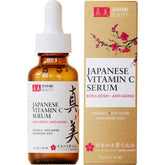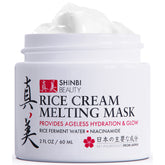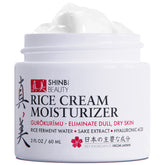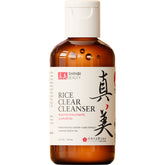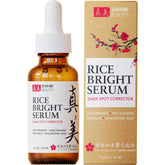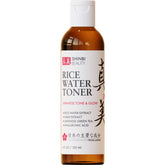Why Japanese Skincare Is So Effective for Oily Skin
Hey there, radiant reader!
You’ve clicked into the ultimate roadmap to understanding Japanese skincare for oily skin.
Yes, you read right. We’re about to spill all the tea, but in a fancy tea ceremony way (because, Japan).
So, sit tight, grab your green tea, and let’s unravel the secret world of Japanese skincare, especially crafted for you and your glorious oily skin.
Setting the Canvas: Why Oily Skin isn’t the Villain
First and foremost, let’s knock down that big old brick wall of a myth: Oily skin is NOT a curse.
Let’s dive a bit deeper.
From a biological perspective, the sebaceous glands in our skin produce sebum (fancy word for natural oil).
This slick substance is crucial; it keeps our skin soft, hydrated, and protected. But for some of us, these glands are a tad more enthusiastic, producing oil in abundance.
But here's the silver lining – and we're not just talking about that radiant sheen on your cheeks. Oily skin tends to age slower.
Wrinkles? Well, they often have a harder time setting up shop on oily skin. This skin type retains its elasticity a little longer, thanks to that natural moisturizer.
Now, think of oily skin as nature’s very own, meticulously crafted highlighter. Some folks drop serious cash trying to achieve that coveted dewy finish, and here you are, naturally flaunting it.
When the afternoon light hits just right, that sheen on your face? Honey, that’s Mother Nature whispering, “You’re rocking that natural glow!”
But let’s get real for a sec. While it’s a gift in many ways, oily skin can also bring along some uninvited guests: larger pores, frequent breakouts, and a sometimes maddening shine that could blind satellites.
Yep, just like every superpower, it comes with its challenges and needs some guidance to harness its full potential.
Enter the enchanting world of Japanese skincare, where centuries of beauty wisdom meet cutting-edge science.
The Japanese beauty regimen is not about stifling your skin's natural tendencies. Nope. It's about understanding, balancing, and guiding.
Rather than wage war against our skin's natural state, Japanese skincare philosophies teach us to walk hand in hand with it, maintaining harmony.
The ingredients commonly found in Japanese skincare products, like green tea and rice water, are inherently calming and balancing. They don’t storm in, attempting to transform your skin entirely. Instead, they subtly nudge it towards equilibrium, ensuring that the oil production is neither too little nor too much.
Moreover, if you’ve ever experienced the beauty of Japanese skincare routines, you’d know they’re not just routines – they’re rituals.
It's not a hurried smear of lotion on the face; it's a meditative, deliberate application of products that respect and highlight your skin's inherent nature.
It's about celebrating the skin you're in, not shaming it.
Dive into Double-Cleansing
Ah, the world of double-cleansing!
If you’re new to this, prepare to have your skincare game seriously elevated.
If you’re already acquainted, well, honey, let's dive deeper into the nitty-gritty. Because, truth be told, there’s an art, a science, and a whole lotta love behind this method.
First off, let’s answer the burning question: Why double-cleansing?
Our skin, especially the oily kind, is a bustling metropolis.
There's the natural sebum, the remnants of your SPF warrior, a sprinkle of atmospheric pollutants, and, oh, that stubborn waterproof mascara from last night’s party.
So, just like you wouldn’t expect a single swipe with a wet cloth to clean an entire bustling city, our skin needs a bit more than a simple wash to truly come clean.
Step 1: Oil-Based Cleanse
This might sound counterintuitive to some – “Use oil to clean oily skin? Are we bonkers?”
Bear with us! On the molecular level, oil is fantastic at attracting other oils. It's like a magnet for all the oil-based gunk lurking on your face. So, when you gently massage that oil cleanser into your skin, it works diligently to break down the sebum, sunscreen residue, pollutants, and any other oil-soluble impurities.
It’s the law of like attracts like; the cleansing oil binds with the oils on your skin, allowing you to rinse them away effortlessly.
And for those worried about clogged pores: fear not! The cleansing oils used in this process are specifically designed to be non-comedogenic (a fancy word that means it won't block your pores).
Plus, they're often enriched with antioxidants and skin-loving ingredients that leave your skin feeling soft, not stripped.
Step 2: Foam or Water-Based Cleanse
If the oil-based cleanse is like the epic hero of an action movie, this step is the heartwarming denouement.
The foam or water-based cleanser works to pick up any water-based impurities like sweat or leftover traces of dirt that the first cleanser might’ve missed. It’s like a meticulous housekeeper that ensures everything is in pristine condition.
This step is crucial as it makes certain that your skin is truly clean, without that uncomfortable tight feeling. A good foam cleanser froths up beautifully, feels luxurious, and respects the skin’s pH balance.
To give a little science backdrop, our skin thrives when it maintains a slightly acidic pH (around 5.5). Over-cleansing or using products that disrupt this balance can actually kick those sebaceous glands into overdrive, leading to – you guessed it – even oilier skin!
That's why Japanese foam cleansers are carefully formulated to cleanse while keeping that pH balance in check.
In essence, double-cleansing is like a symphony, with each step playing a vital role in the grand performance.
It ensures that your skin is perfectly primed to absorb the goodness of the next steps in your routine. This isn't just a cleansing process; it's a ritual, a celebration of the skin you're in.
Say Hello to Rice Ferment Water Face Masks
Rice isn’t just the star of your favorite sushi; it’s the backstage hero of some standout skincare staples, especially in the Japanese beauty scene.
Enter rice ferment water face masks.
But before you conjure up images of slapping some leftover rice onto your face, hold that thought. There’s science, tradition, and a whole lot of refinement that has gone into this.
The Genesis of Rice Ferment Water
To begin with, let's understand what rice ferment water is.
When rice is fermented, it breaks down into its constituent nutrients and releases a subtly aromatic liquid. This isn’t just any liquid, but a cocktail of amino acids, minerals, vitamins, and organic acids that your skin will absolutely lap up.
Balancing Act: Oil Production
For anyone who’s ever sighed at their skin’s penchant for pumping out oil like it’s on overtime, rice ferment water could be your new BFF.
Why? Because it doesn’t just matte down your face. It actually helps in balancing sebum production.
The magic lies in the presence of certain natural compounds that signal your skin to produce just the right amount of oil - not too much, not too little, just perfect.
Pore-fectly Refined
Enlarged pores – almost every oily-skinned beauty’s nemesis. You cleanse, you tone, and yet they sit there, bold as brass.
Rice ferment water, with its rich mineral content, helps tighten and refine these pores. The logic is straightforward: smaller-looking pores lead to a smoother skin texture, which means your foundation can finally stop settling into those pesky pore pits.
Hydration without the Heaviness
Hydrating oily skin is like walking a tightrope.
You need hydration (because oily doesn’t necessarily mean hydrated), but most products leave you with that greasy aftermath. With that in mind, rice ferment water does double duty - moisturizing and keeping your skin plump, without the heaviness of conventional moisturizers.
This is because the hydration it provides is watery, not oily. It’s like giving your skin a drink of water rather than smearing it with butter.
The All-Star Ingredient
Wondering where to get your hands on this miraculous ingredient? Our signature Rice Cream Melting Mask, infused with rice ferment water, gives you all the benefits of our star ingredient, plus a generous infusion of skin-soothing niacinamide.
Think of it as a spa session, cutting-edge skincare science, and a tradition handed down through generations - all wrapped into one neat little package.
Lightweight Moisturizers are Your Jam
When picturing oily skin, most people conjure up images of shiny foreheads, conspicuous pores, and perhaps an unfortunate acne breakout.
With this in mind, the idea of adding more moisture can seem like adding fuel to a fire.
But here’s the big reveal: oily skin doesn't mean your skin is necessarily hydrated. There’s a massive difference between oiliness and hydration, and that’s where the fascinating world of lightweight moisturizers comes into play.
The Science Behind the Shine
Your skin produces sebum, an oily substance from sebaceous glands, to keep itself moisturized.
Sometimes, these glands work overtime, producing more sebum than necessary, leading to that all-too-familiar shine.
But here's where it gets tricky: if your skin is dehydrated (yes, even oily skin can be parched!), it compensates by producing more oil. It's a well-meaning, but often counterproductive, response.
Why Traditional Creams May Not Cut It
Now, think about the classic thick, creamy moisturizers.
For dry skin, they're a dream, forming a rich blanket of hydration.
But for oily skin? It can be like wearing a wool sweater on a summer day. They sit heavy, can clog pores, and amp up the shine. The problem isn’t the act of moisturizing, but rather, the choice of moisturizer.
Lightweight Champions: Gels, Light Creams, and Water-based Wonders
These moisturizers are like a cool breeze on a humid day. They get absorbed quickly, quenching your skin’s thirst without leaving a greasy film.
Let’s break them down:
-
Gel Moisturizers: Often transparent and cool to the touch, gel moisturizers feel almost like aloe vera gel. They are water-based, which means they hydrate without adding oil. They also have a remarkable ability to lock in moisture, ensuring that the hydration isn't fleeting.
-
Light Creams: These are the middle ground between thick creams and gels. They offer more substance than gels, but without the heaviness of traditional moisturizers. If your skin is combination (oily in some spots, dry in others), light creams might just be your best bet.
- Water-based Potions: Think of them as a hydrating elixir. They are super light, almost watery, and penetrate deep into the skin layers. Their molecular composition allows them to deliver hydration right where it's needed, rebalancing moisture levels without causing congestion.
Choosing Right, Feeling Light
The goal for oily-skinned folks isn’t to eliminate oils but to balance them. Lightweight moisturizers help in doing just that. They restore the hydration balance, signaling your skin that it doesn’t need to produce excess oil.
The result? You feel refreshed, your skin feels plump, and there’s no unsightly sheen, just a natural glow.
Wrapping Up With Love
There you have it! A guide tailored for your unique skin type, lifestyle, and needs.
Just remember, at the end of the day, it’s all about understanding and loving your skin.
So, raise your matcha mug to a journey towards radiance, balance, and embracing the glow!
P.S. Don’t forget to share this guide with your tribe. After all, skincare wisdom is only real when shared!
